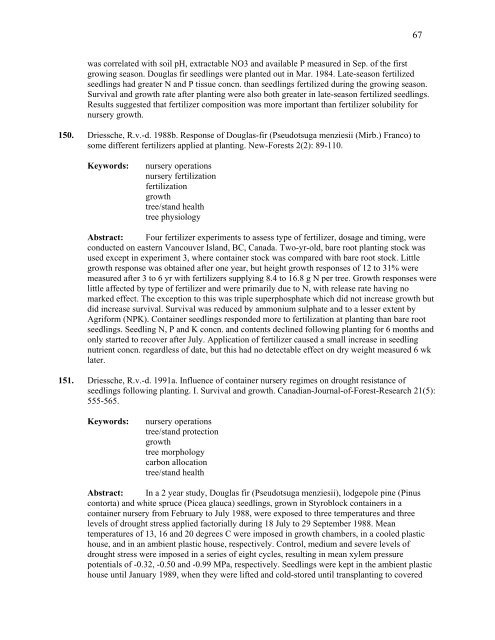IntensIve sIlvIculture - Forest Science Labs - Research Network ...
IntensIve sIlvIculture - Forest Science Labs - Research Network ...
IntensIve sIlvIculture - Forest Science Labs - Research Network ...
You also want an ePaper? Increase the reach of your titles
YUMPU automatically turns print PDFs into web optimized ePapers that Google loves.
was correlated with soil pH, extractable NO3 and available P measured in Sep. of the first<br />
growing season. Douglas fir seedlings were planted out in Mar. 1984. Late-season fertilized<br />
seedlings had greater N and P tissue concn. than seedlings fertilized during the growing season.<br />
Survival and growth rate after planting were also both greater in late-season fertilized seedlings.<br />
Results suggested that fertilizer composition was more important than fertilizer solubility for<br />
nursery growth.<br />
150. Driessche, R.v.-d. 1988b. Response of Douglas-fir (Pseudotsuga menziesii (Mirb.) Franco) to<br />
some different fertilizers applied at planting. New-<strong>Forest</strong>s 2(2): 89-110.<br />
Keywords: nursery operations<br />
nursery fertilization<br />
fertilization<br />
growth<br />
tree/stand health<br />
tree physiology<br />
Abstract: Four fertilizer experiments to assess type of fertilizer, dosage and timing, were<br />
conducted on eastern Vancouver Island, BC, Canada. Two-yr-old, bare root planting stock was<br />
used except in experiment 3, where container stock was compared with bare root stock. Little<br />
growth response was obtained after one year, but height growth responses of 12 to 31% were<br />
measured after 3 to 6 yr with fertilizers supplying 8.4 to 16.8 g N per tree. Growth responses were<br />
little affected by type of fertilizer and were primarily due to N, with release rate having no<br />
marked effect. The exception to this was triple superphosphate which did not increase growth but<br />
did increase survival. Survival was reduced by ammonium sulphate and to a lesser extent by<br />
Agriform (NPK). Container seedlings responded more to fertilization at planting than bare root<br />
seedlings. Seedling N, P and K concn. and contents declined following planting for 6 months and<br />
only started to recover after July. Application of fertilizer caused a small increase in seedling<br />
nutrient concn. regardless of date, but this had no detectable effect on dry weight measured 6 wk<br />
later.<br />
151. Driessche, R.v.-d. 1991a. Influence of container nursery regimes on drought resistance of<br />
seedlings following planting. I. Survival and growth. Canadian-Journal-of-<strong>Forest</strong>-<strong>Research</strong> 21(5):<br />
555-565.<br />
Keywords: nursery operations<br />
tree/stand protection<br />
growth<br />
tree morphology<br />
carbon allocation<br />
tree/stand health<br />
Abstract: In a 2 year study, Douglas fir (Pseudotsuga menziesii), lodgepole pine (Pinus<br />
contorta) and white spruce (Picea glauca) seedlings, grown in Styroblock containers in a<br />
container nursery from February to July 1988, were exposed to three temperatures and three<br />
levels of drought stress applied factorially during 18 July to 29 September 1988. Mean<br />
temperatures of 13, 16 and 20 degrees C were imposed in growth chambers, in a cooled plastic<br />
house, and in an ambient plastic house, respectively. Control, medium and severe levels of<br />
drought stress were imposed in a series of eight cycles, resulting in mean xylem pressure<br />
potentials of -0.32, -0.50 and -0.99 MPa, respectively. Seedlings were kept in the ambient plastic<br />
house until January 1989, when they were lifted and cold-stored until transplanting to covered<br />
67
















